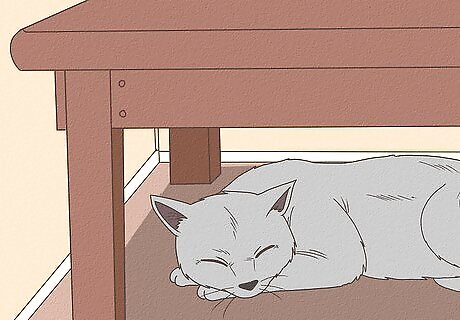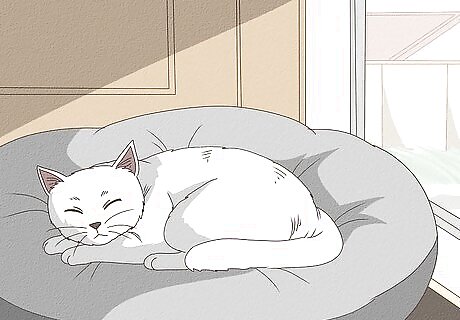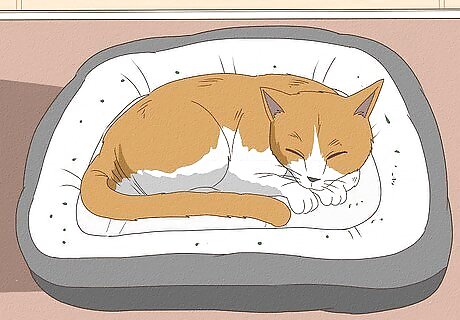
views
Choosing the Best Bed Location

Observe where your cat likes to sleep. Paying attention to where your cat likes to sleep will help you find a good spot for its bed. Most cats like to sleep in warm areas that offer safety and seclusion but still offer a good vantage point. If you notice your cat likes to sleep in a specific spot, try placing the bed at or nearby that location first.

Place the bed in a low traffic area. Cats prefer to maintain some personal space, so go with a quiet location away from your home’s main thoroughfares. In high traffic areas, your cat will feel like it's always visible and won’t want to rest or sleep. Examples of quiet spots include a spare bedroom, under a table, or a quiet corner in the den or living room.

Give your cat a good view. Cats love to be able to see without being seen. In addition to providing warmth, placing the bed by a sunlit window lets your cat watch out for passing birds and other wildlife. Partially concealing the bed with floor-length curtains will further encourage your cat to use it. The window will provide a view and warmth, and the curtains will give it a sense of security.

Elevate the bed or go with a perch if your cat likes height. Cats naturally enjoy heights and, for some, sleeping on the floor makes them feel too vulnerable. Try placing the bed on an ottoman, chair, or other piece of furniture. You could also provide your cat with a tree perch or a bed that attaches to a window sill. Just make sure the bed is secure so it doesn't fall and cause injuries. An elevated perch might be your best option if your cat prefers sleeping on the back of the sofa, a dining room chair, or other elevated surface. It might seem counterintuitive to place a bed on a chair or sofa, but it might help you reduce the amount of cat hair that builds up on your furniture.

Try a new spot if your cat ignores its bed. If your cat doesn’t seem interested in a new bed, your first solution should be to switch up its location. Finding a more desirable spot for the bed is usually an effective way to encourage your cat to use it. Place the bed somewhere secluded, sunlit, and warm, or where you see it sleeping the most. You can also try moving it to various spots in your home to follow the sun as it moves across the sky.
Introducing Your Cat to Its Bed

Make sure the bed is clean. Cats don’t like soiled environments or strange smells, so you should make sure the bed is clean before introducing your cat to it. If your cat avoids a new bed even though you’ve placed it in a good sleeping spot, it might not like the way the new bed smells. If your cat suddenly stops using a bed, chances are it’s due for a wash. Keep in mind a brand new bed will smell like the factory and store it came from, so it’s a good idea to wash it before introducing it to your cat. If you’ve acquired a bed secondhand, be sure to wash it before letting your cat use it. Beds with removable washable covers or that are entirely machine washable are excellent options. You can also consider spraying the bed with catnip to attract the cat and help it move past the new bed smell.

Place some of your cat’s toys in the bed. Once you’ve chosen a good location for the bed, place some of your cat’s toys in it. The toys will smell like your cat and help familiarize it with its bed. Leave the toys in the bed for least a day, but don’t pick your cat up and bring it to the bed. Give it time to figure out what the bed is for on its own.

Offer treats and praise when your cat goes to its bed. Giving your cat attention when you notice it using its bed will help it form a positive association with the bed. Offer lots of verbal praise, pet it, and offer it a small treat. Give your cat treats and praise only when you first see it get into its bed. Cats don’t like being disturbed while they sleep. Petting or praising your cat while it’s sleeping might make it dislike the bed.

Try not to force your cat into the bed. Do your best to make sure your cat doesn’t form a negative association with the bed. Switch up the bed’s location and make it more appealing instead of holding your cat in the bed, yelling at it, or otherwise forcing it to use the bed, as that is not humane treatment. If your cat associates the bed with being held down or yelled at, it won’t go anywhere near the bed.
Making the Bed More Appealing

Use catnip to coax your cat to its bed. If it seems disinterested, try sprinkling some catnip in the bed to encourage your cat to lay in it. Keep in mind catnip makes some cats mellow, others more playful, and has no effect on almost half of cats. For best results, pay attention to how your cat reacts to catnip.

Try lining the bed with clothing or fabric that smells like you. While cats prefer a nice, clean bed, they also love familiar scents. Putting a worn T-shirt or sweater in their bed often works wonders. Fleece is a great fabric choice, as most cats enjoy how it feels. You could also use a towel. Once your cat is used to the new smell, you can retrieve your garment. Making its bed smell like you will help encourage your cat to use its bed instead of getting into your bed.

Provide your cat with multiple beds. Cats instinctively sleep in multiple locations over the course of a day. To encourage bed use, try placing multiple beds throughout your home in each of its preferred sleeping locations. Try incorporating different kinds of beds, like elevated beds, cave or hooded beds, and pillow beds. From using cardboard boxes to repurposing an old sweater, you can reduce the cost of providing multiple beds by creating homemade cat beds.

Get a heated bed or heating pad to help your cat get comfortable. Getting a heated bed can help your cat feel more comfortable, especially during the colder winter months. Lightly heated beds can also help older cats or those with joint problems feel more comfortable. If your cat really likes their regular bed, you can get a bed heating pad to place underneath.


















Comments
0 comment